Bulbil Formation on Water Yam (Dioscorea alata L.) Is Promoted by Waterlogged Soil
Abstract
1. Introduction
2. Materials and Methods
2.1. Plant Material and Growth Conditions
2.2. Waterlogging Treatment
2.3. Evaluation of Bulbil Formation
2.4. Microscopic Observation of Leaf Axils
2.5. Measurement of Dry Matter Production
2.6. Measurement of Photosynthetic Gas Exchange
2.7. Evaluation of 13C-Photoassimilate Translocation
2.8. ABA and GA Treatments
2.9. Statistical Analysis
3. Results and Discussion
3.1. Effects of Waterlogging Stress on Bulbil Formation
3.2. Morphological Characteristics of Bulbil
3.3. Dry Matter Production and Tuber Yield under Waterlogging Stress
3.4. Effect of Waterlogging Stress on Photosynthetic Traits and Photoassimilate Allocation
3.5. Effects of ABA and GA Treatment on Bulbil Formation
4. Conclusions
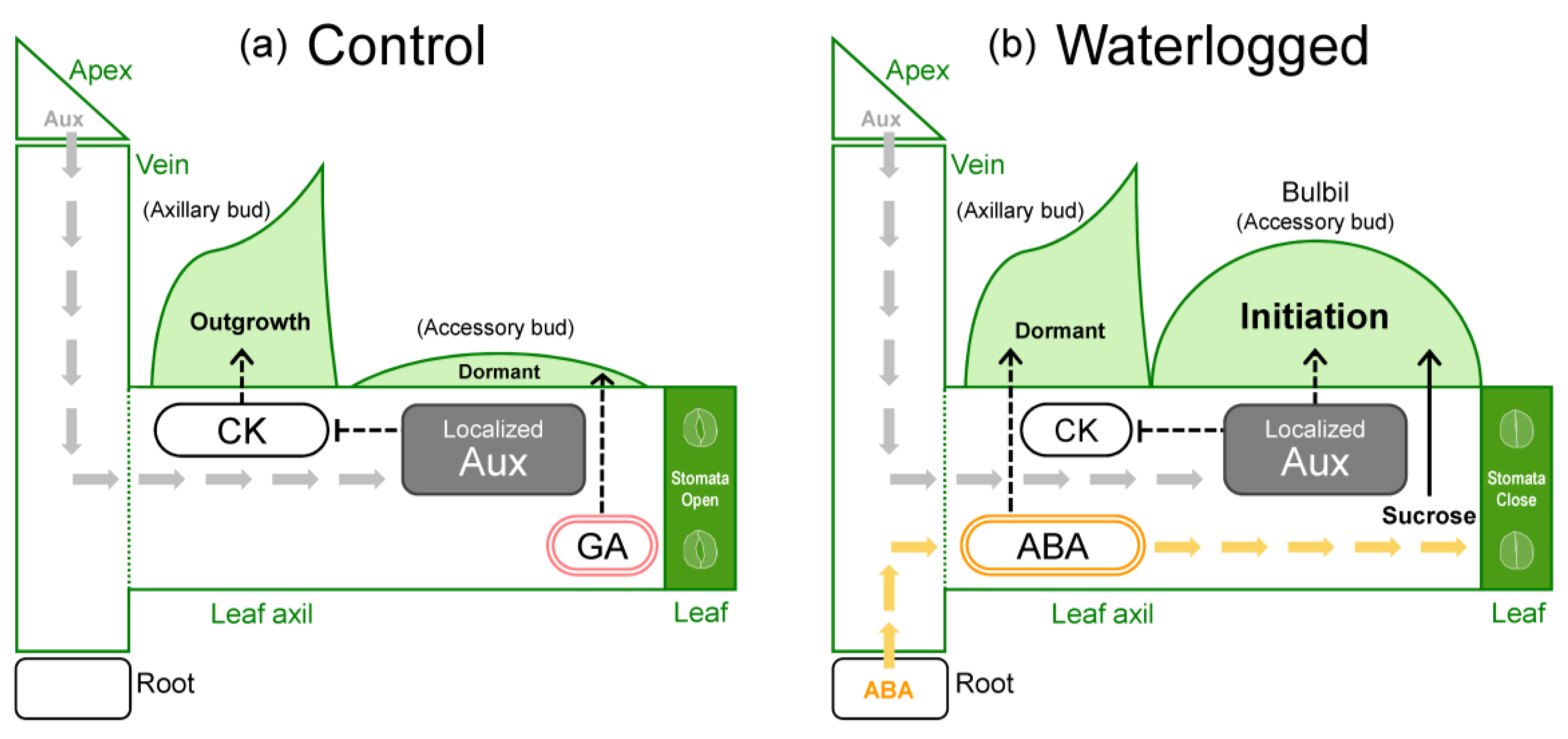
Supplementary Materials
Author Contributions
Funding
Data Availability Statement
Acknowledgments
Conflicts of Interest
References
- Ayensu, E.S.; Coursey, D.G. Guinea yams: The botany, ethnobotany, use and possible future of yams in West Africa. Econ. Bot. 1972, 26, 301–318. [Google Scholar] [CrossRef]
- Sartie, A.; Asiedu, R.; Franco, J. Genetic and phenotypic diversity in a germplasm working collection of cultivated tropical yams (Dioscorea spp.). Genet. Resour. Crop. Evol. 2012, 59, 1753–1765. [Google Scholar] [CrossRef]
- Lebot, V. Section III. In Yams in Tropical Root and Tuber Crops: Cassava, Sweet Potato, Yams and Aroids 181–275; CABI: Wallingford, UK, 2008. [Google Scholar] [CrossRef]
- Girma, G.; Hyma, K.E.; Asiedu, R.; Mitchell, S.E.; Gedil, M.; Spillane, C. Next generation sequencing based genotyping, cytometry and phenotyping for understanding diversity and evolution of guinea yams. Theor. Appl. Genet. 2014, 127, 1783–1794. [Google Scholar] [CrossRef] [PubMed]
- Wickham, L.D.; Wilson, L.A.; Passam, H.C. The origin, development and germination of bulbils in two Dioscorea species. Ann. Bot. 1982, 50, 621–627. [Google Scholar] [CrossRef]
- Murty, Y.S.; Purnima. Morphology, anatomy and development of bulbil in some Dioscoreas. Proc. Indian Acad. Sci. (Plant Sci.) 1983, 92, 443–449. [Google Scholar] [CrossRef]
- Szarek, S.R.; Driscoll, B.; Shohet, C.; Priebe, S. Bulbil production in Agave (Agavaceae) and related genera. Southwest. Nat. 1996, 41, 465–469. [Google Scholar]
- Ronsheim, M.L.; Bever, J.D. Genetic variation and evolutionary tradeoffs for sexual and asexual reproductive modes in Allium vineale (Liliaceae). Am. J. Bot. 2000, 87, 1769–1777. [Google Scholar] [CrossRef]
- Wang, C.N.; Moller, M.; Cronk, Q.C. Altered expression of GFLO, the Gesneriaceae homologue of FLORICAULA/LEAFY, is associated with the transition to bulbil formation in Titanotrichum oldhamii. Dev. Genes Evol. 2004, 214, 122–127. [Google Scholar] [CrossRef]
- Asiedu, R.; Sartie, A. Crops that feed the world 1. Yams. Food Secur. 2010, 2, 305–315. [Google Scholar] [CrossRef]
- Walck, J.L.; Cofer, M.S.; Hidayati, S.N. Understanding the germination of bulbils from an ecological perspective: A case study on Chinese yam (Dioscorea polystachya). Ann. Bot. 2010, 106, 945–955. [Google Scholar] [CrossRef]
- Zona, S.; Howard, C.C. Aerial vegetative diaspores of angiosperms: Terminology, organography, and dispersal. Flora 2021, 287, 151989. [Google Scholar] [CrossRef]
- Yoshida, Y.; Takahashi, H.; Kanda, H.; Kanahama, K. Interactive effects of photoperiods and plant growth regulators on the development of tubers and flowering spikes in Chinese Yam (Dioscorea opposita) cv. Nagaimo. J. Jpn. Soc. Hort. Sci. 2002, 71, 752–757. [Google Scholar] [CrossRef]
- Yoshida, Y.; Takahashi, H.; Kanda, H.; Kanahama, K. Effect of seed tuber weights on the development of tubers and flowering spikes in Japanese yams (Dioscorea japonica) grown under different photoperiods and with plant growth regulators. J. Japan. Soc. Hortic. Sci. 2007, 76, 230–236. [Google Scholar] [CrossRef]
- Epping, J.; Laibach, N. An underutilized orphan tuber crop—Chinese yam: A review. Planta 2020, 252, 58. [Google Scholar] [CrossRef]
- Kim, S.K.; Lee, S.C.; Lee, B.H.; Choi, H.J.; Kim, K.U.; Lee, I.J. Bulbil formation and yield responses of Chinese yam to application of gibberellic acid, mepiquat chloride and trinexapac-ethyl. J. Agron. Crop. Sci. 2003, 189, 255–260. [Google Scholar] [CrossRef]
- Kim, S.K.; Lee, S.C.; Shin, D.H.; Jang, S.W.; Nam, J.W.; Park , T.S.; Lee, I.J. Quantification of endogenous gibberellins in leaves and tubers of Chinese yam, Dioscorea opposita Thunb. cv. Tsukune during tuber enlargement. Plant Growth Regul. 2003, 39, 125–130. [Google Scholar] [CrossRef]
- Shiwachi, H.; Chang, K.J.; Hayashi, M. Ecological and morphological characterization and general evaluation of the introduced yams (Dioscorea alata L.). Bull. Fac. Agric. Kagoshima Univ. 1995, 45, 1–17. [Google Scholar]
- Hamaoka, N.; Moriyama, T.; Taniguchi, T.; Suriyasak, C.; Ishibashi, Y. Identification of phenotypic traits associated with tuber yield performance in non-staking cultivation of water yam (Dioscorea alata L.). Agronomy 2022, 12, 2323. [Google Scholar] [CrossRef]
- Hamaoka, N.; Uchida, Y.; Tomita, M.; Kumagai, E.; Araki, T.; Ueno, O. Genetic variations in dry matter production, nitrogen uptake, and nitrogen use efficiency in the AA genome Oryza species grown under different nitrogen conditions. Plant Prod. Sci. 2013, 16, 107–116. [Google Scholar] [CrossRef]
- Sanada, A.; Cheng, C.; Kikuno, H.; Siwachi, H. Bulbil dormancy and formation in water yam (Dioscorea alata L.). Trop. Agr. Develop. 2018, 62, 109–114. [Google Scholar]
- Shimizu-Sato, S.; Mori, H. Control of outgrowth and dormancy in axillary buds. Plant Physiol. 2001, 127, 1405–1413. [Google Scholar] [CrossRef] [PubMed]
- Kumari, S.; Jayapal, A.; Padmanabhan, V.B. Tropical tuber crops. In Abiotic Stress Physiology of Horticultural Crops; Springer: New Delhi, India, 2016; pp. 358–359. [Google Scholar]
- Else, M.A.; Tiekstra, A.E.; Croker, S.J.; Davies, W.J.; Jackson, M.B. Stomatal closure in flooded tomato plants involves abscisic acid and a chemically unidentified anti-transpirant in xylem sap. Plant Physiol. 1996, 112, 239–247. [Google Scholar] [CrossRef] [PubMed]
- Ahmed, S.; Nawata, E.; Hosokawa, M.; Domae, Y.; Sakuratani, T. Alterations in photosynthesis and some antioxidant enzymatic activities of mungbean subjected to waterlogging. Plant Sci. 2002, 163, 117–123. [Google Scholar] [CrossRef]
- Araki, T.; Nguyen, M.T.P.; Kubota, F. Specific feature in photosynthetic response of kenaf (Hibiscus cannabinus L.) to flooding stress. Environ. Control Biol. 2012, 50, 127–134. [Google Scholar] [CrossRef]
- Ploschuk, R.A.; Miralles, D.J.; Colmer, T.D.; Ploschuk, E.L.; Striker, G.G. Waterlogging of winter crops at early and late stages: Impacts on leaf physiology, growth and yield. Front. Plant Sci. 2018, 9, 1863. [Google Scholar] [CrossRef]
- Pan, J.; Sharif, R.; Xu, X.; Chen, X. Mechanisms of waterlogging tolerance in plants: Research progress and prospects. Front. Plant Sci. 2021, 11, 627331. [Google Scholar] [CrossRef]
- Nilsen, E.T.; Orcutt, D.M. Physiology of Plants under Stress; John Wiley & Sons, Inc.: New York, NY, USA, 1996. [Google Scholar]
- Herzog, M.; Striker, G.G.; Colmer, T.D.; Pedersen, O. Mechanisms of waterlogging tolerance in wheat–a review of root and shoot physiology. Plant Cell Environ. 2016, 39, 1068–1086. [Google Scholar] [CrossRef]
- Wu, Z.G.; Jiang, W.; Tao, Z.M.; Pan, X.J.; Yu, W.H.; Huang, H.L. Morphological and stage-specific transcriptome analyses reveal distinct regulatory programs underlying yam (Dioscorea alata L.) bulbil growth. J. Exp. Bot. 2020, 71, 1899–1914. [Google Scholar] [CrossRef]
- Jackson, S.D.; Prat, S. Control of tuberization in potato by gibberellins and phytochrome B. Physiol. Plant 1996, 98, 407–412. [Google Scholar] [CrossRef]
- Okagami, N.; Nagao, M. Gibberellin-induced dormancy in bulbils of Dioscorea. Planta 1971, 101, 91–94. [Google Scholar] [CrossRef]
- Tanno, N.; Yokota, T.; Abe, M.; Okagami, N. Identification of endogenous gibberellins in dormant bulbils of Chinese yam, Dioscorea opposita. Plant Physiol. 1992, 100, 1823–1826. [Google Scholar] [CrossRef] [PubMed]
- Nicolas, M.; Torres-Pérez, R.; Wahl, V.; Cruz-Oró, E.; Rodríguez-Buey, M.L.; Zamarreño, A.M.; Martín-Jouve, B.; García-Mina, J.M.; Oliveros, J.C.; Prat, S.; et al. Spatial control of potato tuberization by the TCP transcription factor BRANCHED1b. Nat. Plants 2022, 8, 281–294. [Google Scholar] [CrossRef] [PubMed]
- Yao, C.; Finlayson, S.A. Abscisic acid is a general negative regulator of Arabidopsis axillary bud growth. Plant Physiol. 2015, 169, 611–626. [Google Scholar] [CrossRef] [PubMed]
- Gonzalez-Grandio, E.; Pajoro, A.; Franco-Zorrilla, J.M.; Tarancon, C.; Immink, R.G.H.; Cubas, P. Abscisic acid signaling is controlled by a BRANCHED1/HD-ZIP I cascade in Arabidopsis axillary buds. Proc. Natl. Acad. Sci. USA 2017, 114, E245–E254. [Google Scholar] [CrossRef] [PubMed]
- Noriega, X.; Pérez, F.J. ABA biosynthesis genes are down-regulated while auxin and cytokinin biosynthesis genes are up-regulated during the release of grapevine buds from endodormancy. J. Plant Growth Regul. 2017, 36, 814–823. [Google Scholar] [CrossRef]
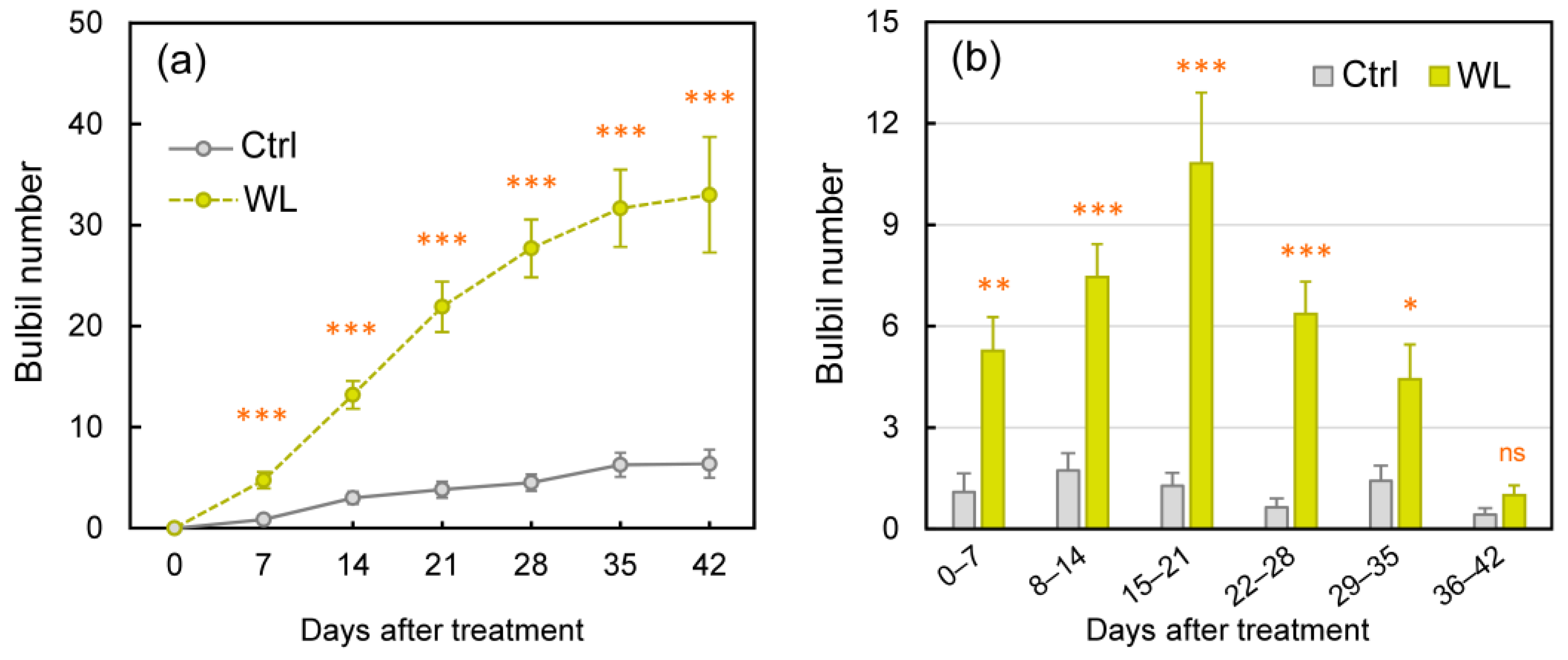
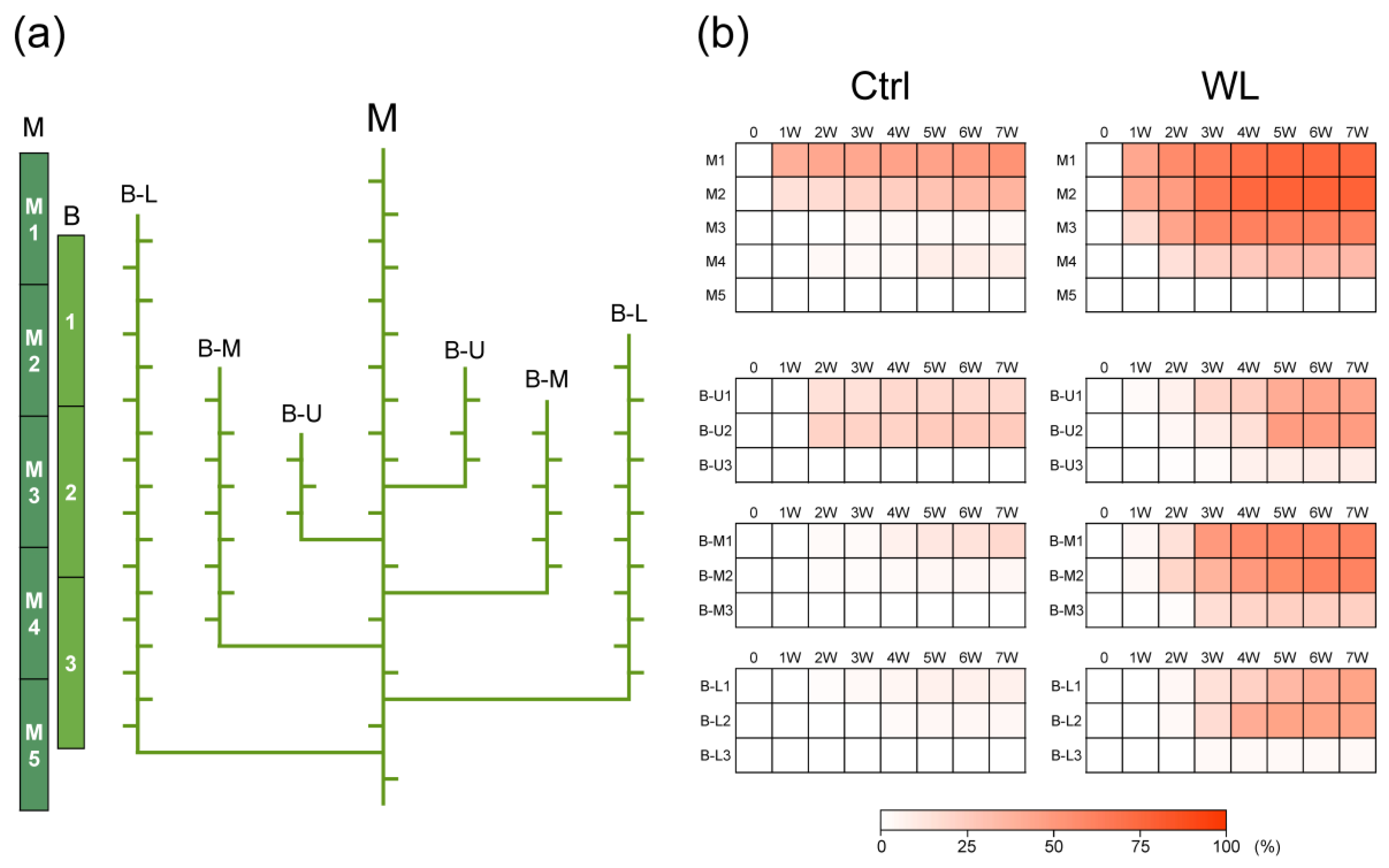
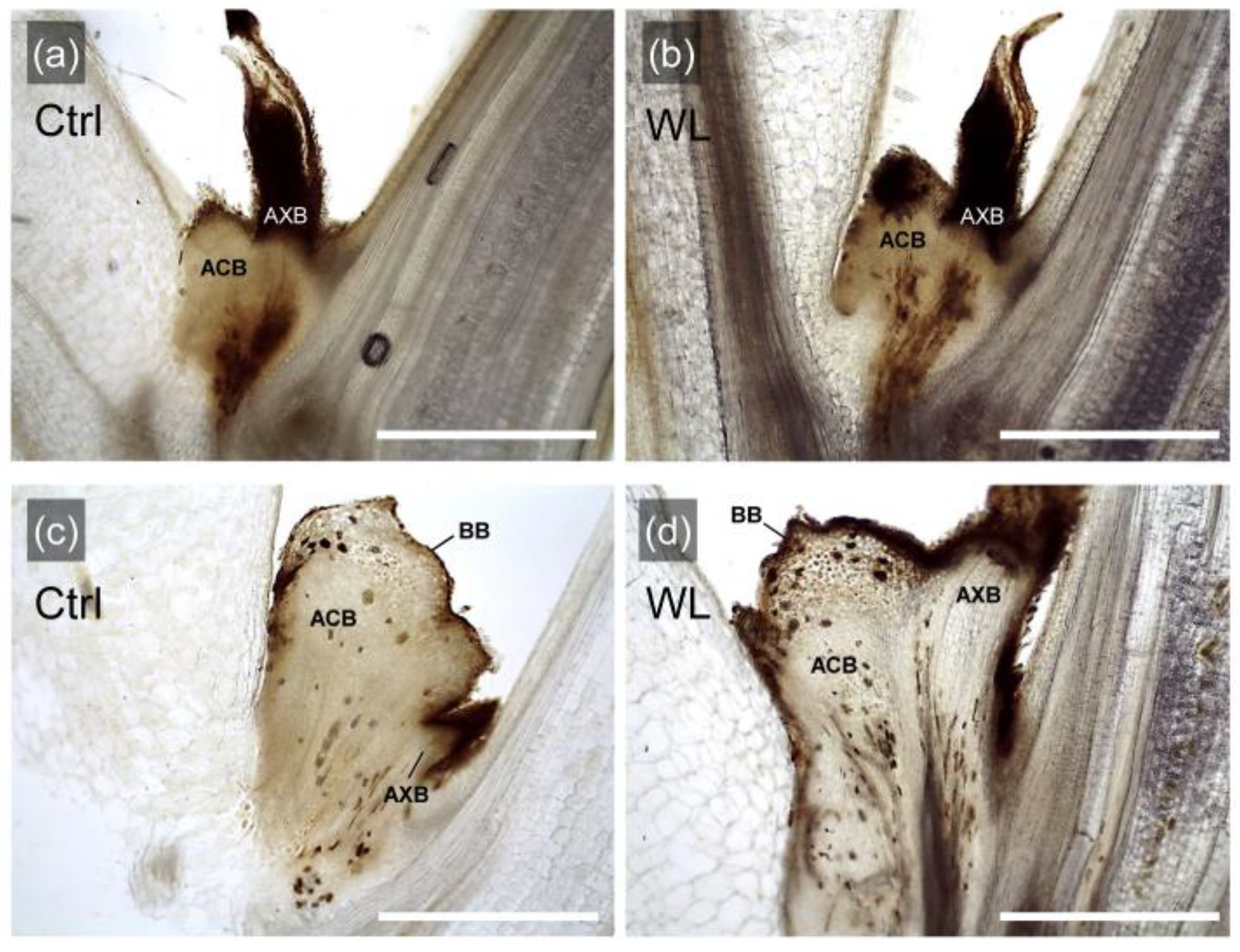
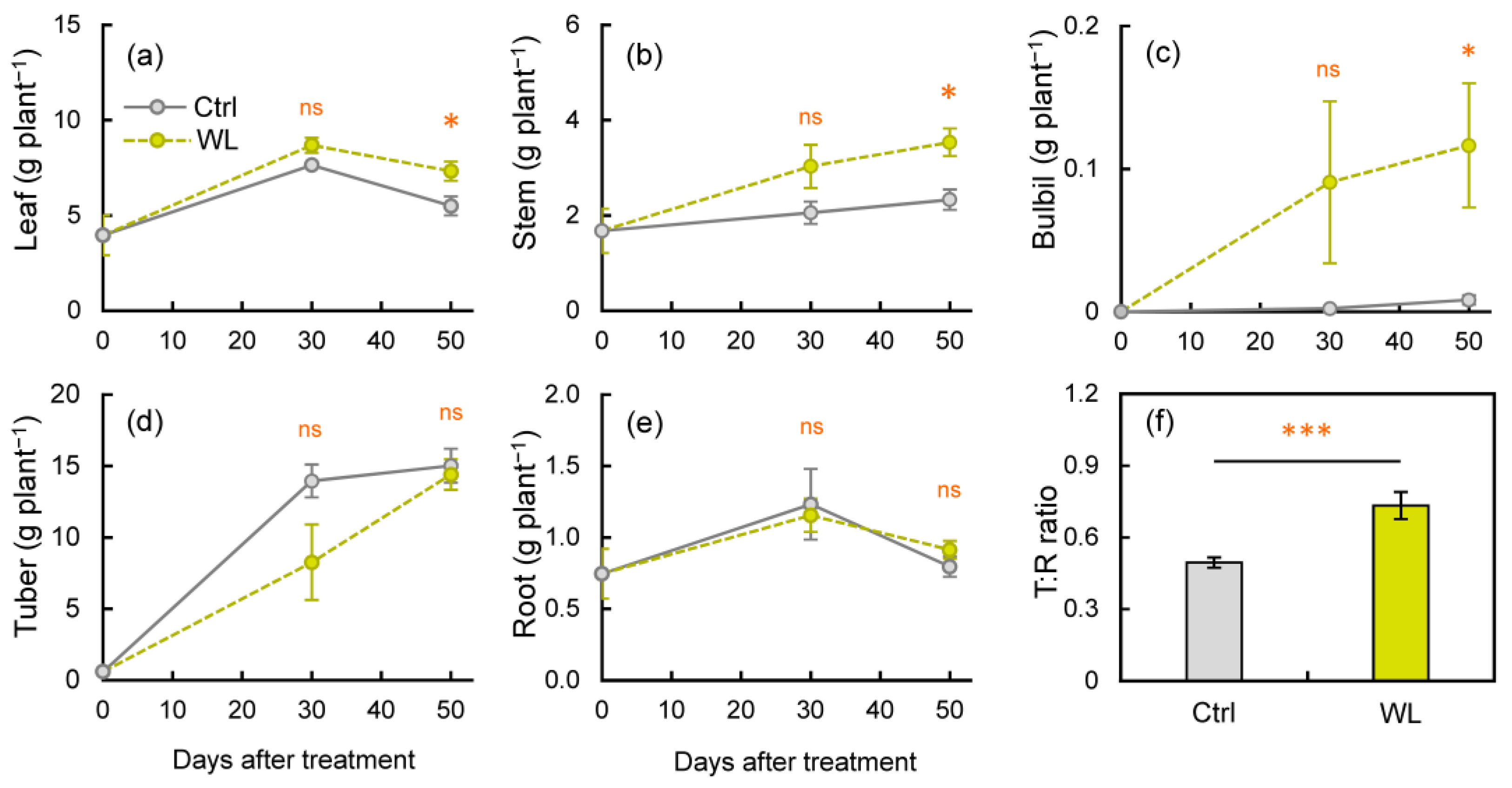
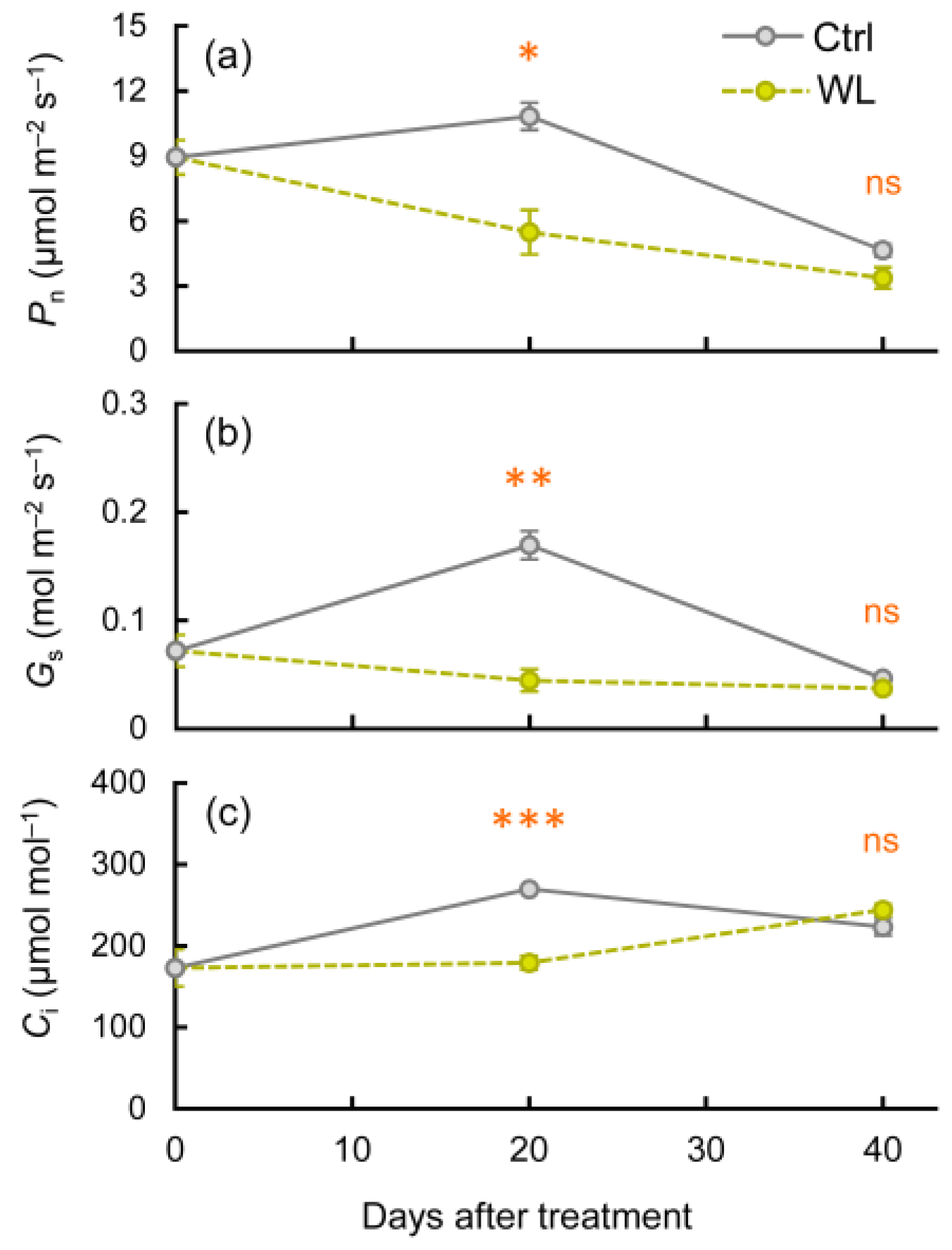
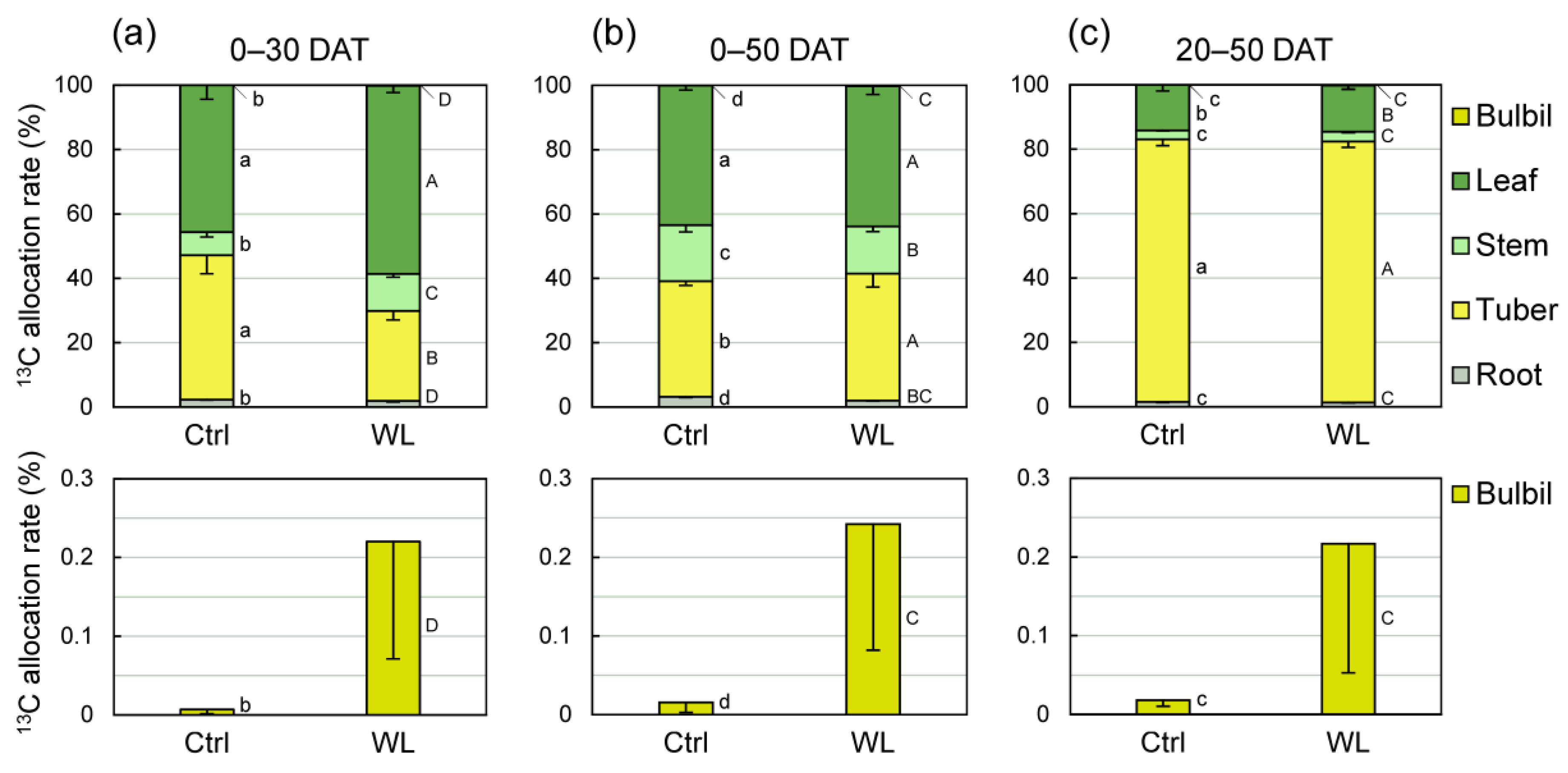
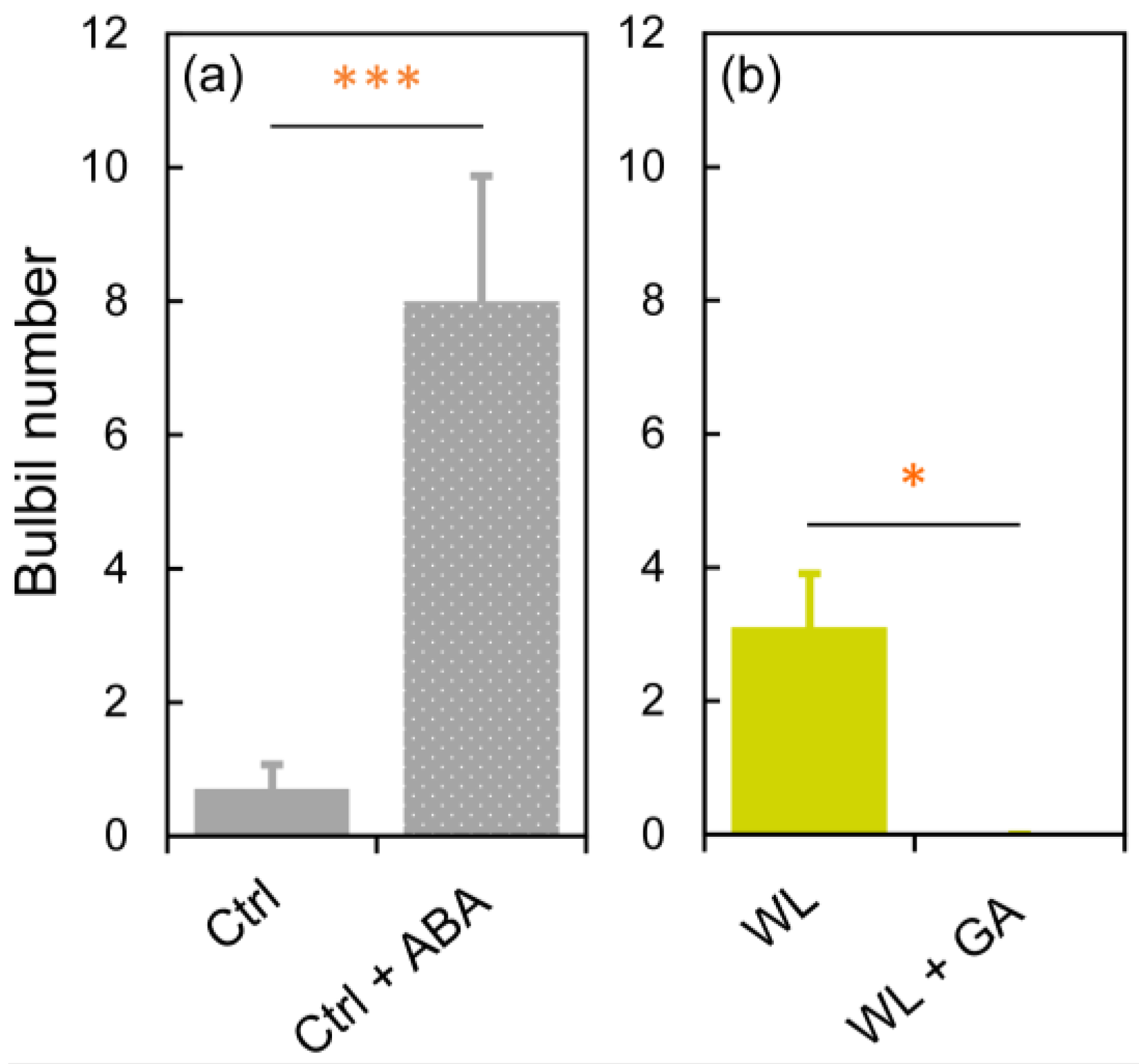
Disclaimer/Publisher’s Note: The statements, opinions and data contained in all publications are solely those of the individual author(s) and contributor(s) and not of MDPI and/or the editor(s). MDPI and/or the editor(s) disclaim responsibility for any injury to people or property resulting from any ideas, methods, instructions or products referred to in the content. |
© 2023 by the authors. Licensee MDPI, Basel, Switzerland. This article is an open access article distributed under the terms and conditions of the Creative Commons Attribution (CC BY) license (https://creativecommons.org/licenses/by/4.0/).
Share and Cite
Hamaoka, N.; Moriyama, T.; Taniguchi, T.; Suriyasak, C.; Ishibashi, Y. Bulbil Formation on Water Yam (Dioscorea alata L.) Is Promoted by Waterlogged Soil. Agronomy 2023, 13, 484. https://doi.org/10.3390/agronomy13020484
Hamaoka N, Moriyama T, Taniguchi T, Suriyasak C, Ishibashi Y. Bulbil Formation on Water Yam (Dioscorea alata L.) Is Promoted by Waterlogged Soil. Agronomy. 2023; 13(2):484. https://doi.org/10.3390/agronomy13020484
Chicago/Turabian StyleHamaoka, Norimitsu, Takahito Moriyama, Takatoshi Taniguchi, Chetphilin Suriyasak, and Yushi Ishibashi. 2023. "Bulbil Formation on Water Yam (Dioscorea alata L.) Is Promoted by Waterlogged Soil" Agronomy 13, no. 2: 484. https://doi.org/10.3390/agronomy13020484
APA StyleHamaoka, N., Moriyama, T., Taniguchi, T., Suriyasak, C., & Ishibashi, Y. (2023). Bulbil Formation on Water Yam (Dioscorea alata L.) Is Promoted by Waterlogged Soil. Agronomy, 13(2), 484. https://doi.org/10.3390/agronomy13020484




